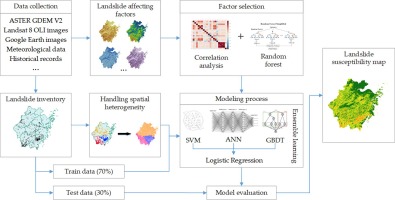Catena ( IF 6.2 ) Pub Date : 2020-01-08 , DOI: 10.1016/j.catena.2019.104425 Yumiao Wang , Luwei Feng , Sijia Li , Fu Ren , Qingyun Du

|
Landslides are a type of serious geologic disaster causing great damage to the human environment. Landslide susceptibility mapping is an effective means to reduce landslide risk. However, previous studies have not considered spatial heterogeneity. In this study, a hybrid model considering spatial heterogeneity is designed by integrating GeoSOM and Stacking ensemble methods and is applied to map the landslide susceptibility of Zhejiang Province, China. The GeoSOM method was used to cluster the study area into several homogeneous regions to solve the heterogeneity problem, and each region was assigned a cluster attribute as one of the landslide model inputs. The Stacking ensemble technique was utilized to design a high-performance landslide model by combining three traditional machine learning methods (support vector machine (SVM), artificial neural network (ANN), and gradient-boosting decision tree (GBDT)). We collected 1051 landslide samples and fourteen affecting factors after feature selection. For landslide modelling, the landslides were randomly split into two subsets: 70% samples for training and the rest for validation. Landslide models were assessed by the receiver operating characteristic (ROC) curve and statistical measures. The results indicated that the hybrid model was 0.11–0.135 higher than those of traditional machine learning methods in term of the area under the ROC curve (AUC). In general, this hybrid model can generate high-quality landslide susceptibility maps and help to develop policies that reduce the burden of landslides.



























 京公网安备 11010802027423号
京公网安备 11010802027423号